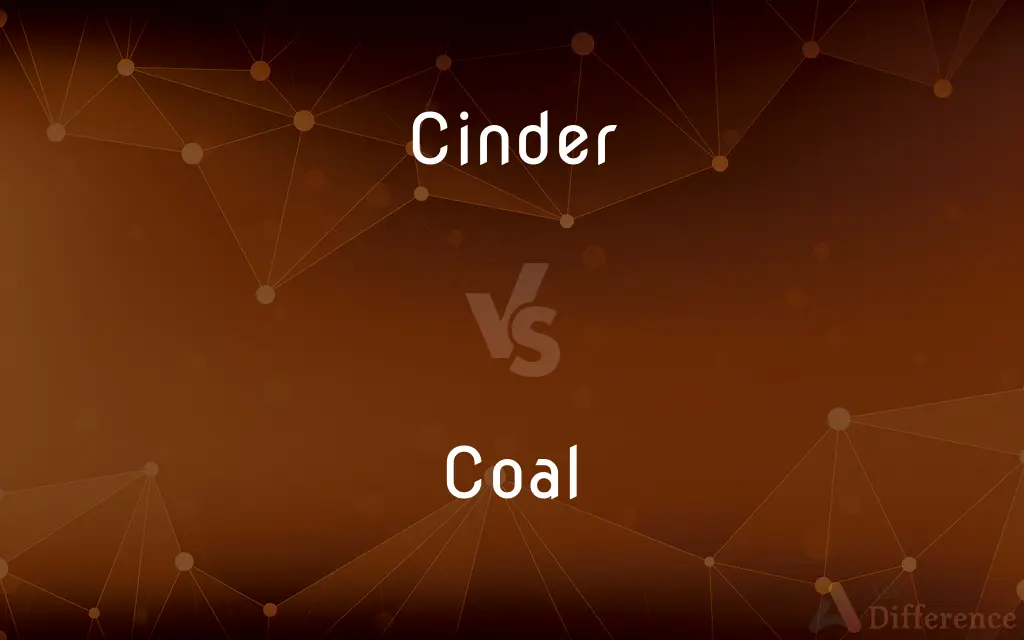Cinder vs. Coal — What's the Difference?
Edited by Tayyaba Rehman — By Fiza Rafique — Updated on April 2, 2024
Cinder is a residue of combustion, consisting of ash and small bits of incompletely burned material, while coal is a fossil fuel formed from plant remains, used primarily for generating heat and electricity.

Difference Between Cinder and Coal
Table of Contents
ADVERTISEMENT
Key Differences
Cinders are the byproducts of burned materials, often left after wood or coal has been combusted, mainly composed of ash and small, charred pieces that did not fully burn away. These remnants are lightweight, porous, and have a grayish-black appearance. In contrast, coal is a natural mineral formed over millions of years from the decomposition of plant matter under heat and pressure, characterized by its black, dense, and solid form, which when burned, releases a significant amount of energy, making it a vital energy source worldwide.
While cinders are used in lightweight construction materials, as a traction aid on icy roads, and in gardening for soil aeration, coal's primary use is in the production of electricity, steel manufacturing, and as a fuel for industrial and domestic heating. This highlights the difference in their applications stemming from their distinct physical and chemical properties.
The environmental impact of using coal is substantial, contributing to air pollution, greenhouse gas emissions, and global warming. Conversely, cinders, being a waste product, have a lesser direct environmental impact but managing them can be challenging, ensuring they do not contaminate water or soil.
In terms of energy content, coal is much more energy-dense than cinders. Cinders have little to no energy value left, as they are essentially the waste left after combustion, whereas coal is sought after for its high energy content, capable of sustaining long, intense burns in power plants and furnaces.
The formation of coal is a natural geological process that takes millions of years, involving the transformation of plant material into carbon-rich rocks. Cinders, however, are a direct result of human activity — the combustion of solid fuels like wood and coal for heat or energy, highlighting the contrast between a naturally occurring mineral and a byproduct of combustion.
ADVERTISEMENT
Comparison Chart
Composition
Ash and partially burned material
Carbon-rich, formed from decomposed plants
Formation
Byproduct of combustion
Natural geological process over millions of years
Use
Construction material, traction aid, gardening
Electricity generation, steel production, heating
Environmental Impact
Lesser direct impact, waste management issues
Significant, contributes to pollution and global warming
Energy Content
Low to none
High, used as a primary energy source
Compare with Definitions
Cinder
Traction aid on ice.
The city spread cinders on roads to improve winter driving conditions.
Coal
Dense and carbon-rich.
Coal's high carbon content makes it a potent source of energy.
Cinder
Used in lightweight concrete.
Cinder blocks are popular for their lightweight and insulating properties.
Coal
Fossil fuel from plants.
Coal mining remains a significant industry in some regions, despite environmental concerns.
Cinder
Porous and lightweight.
Cinders are used in gardening to aerate soil, enhancing plant growth.
Coal
Forms over millions of years.
The coal we use today began forming during the Carboniferous period.
Cinder
Residue from combustion.
The fireplace was filled with cinders after a night of burning wood.
Coal
Used in electricity generation.
The power plant burns coal to produce most of the town's electricity.
Cinder
Ash and unburnt material.
Cleaning the grill involved removing ash and cinders from the charcoal.
Coal
Environmental concerns.
Burning coal is a leading cause of greenhouse gas emissions worldwide.
Cinder
A cinder is a pyroclastic material. Cinders are extrusive igneous rocks; they are fragments of solidified lava.
Coal
Coal is a combustible black or brownish-black sedimentary rock, formed as rock strata called coal seams. Coal is mostly carbon with variable amounts of other elements, chiefly hydrogen, sulfur, oxygen, and nitrogen.
Cinder
A small piece of partly burnt coal or wood that has stopped giving off flames but still has combustible matter in it
A cold hearth full of cinders
Coal
A combustible black or dark brown rock consisting chiefly of carbonized plant matter, found mainly in underground seams and used as fuel
A coal fire
Two bags of coal
Cinder
Waste matter produced by smelting or refining ore; slag.
Coal
Provide with a supply of coal
Ships had to be coaled and supplied
Cinder
A small piece of burned or partly burned substance, such as coal, that is not reduced to ashes but is incapable of further combustion.
Coal
A natural dark brown to black graphitelike material used as a fuel, formed from fossilized plants and consisting of amorphous carbon with various organic and some inorganic compounds.
Cinder
A piece of charred substance that can burn further but without flame.
Coal
A piece of this substance.
Cinder
Cinders Ashes.
Coal
A glowing or charred piece of solid fuel.
Cinder
Cinders(Geology) See scoria.
Coal
Charcoal.
Cinder
(Metallurgy) See scoria.
Coal
To burn (a combustible solid) to a charcoal residue.
Cinder
Slag from a metal furnace.
Coal
To provide with coal.
Cinder
To burn or reduce to cinders.
Coal
To take on coal.
Cinder
Partially or mostly burnt material that results from incomplete combustion of coal or wood etc.
Coal
(uncountable) A black or brownish black rock formed from prehistoric plant remains, composed largely of carbon and burned as a fuel.
The coal in this region was prized by ironmasters in centuries past, who mined it in the spots where the drainage methods of the day permitted.
Cinder
An ember.
Coal
(countable) A type of coal, such as bituminous, anthracite, or lignite, and grades and varieties thereof, as a fuel commodity ready to buy and burn.
Put some coal on the fire.
Order some coal from the coalyard.
Cinder
Slag from a metal furnace.
Coal
(countable) A piece of coal used for burning this use is less common in American English
Put some coals on the fire.
Cinder
Any strong stimulant added to tea, soda water, etc.
Coal
(countable) A glowing or charred piece of coal, wood, or other solid fuel.
Just as the camp-fire died down to just coals, with no flames to burn the marshmallows, someone dumped a whole load of wood on, so I gave up and went to bed.
Cinder
(transitive) To reduce to cinders.
Coal
Charcoal.
Cinder
(transitive) To cover with cinders.
We plan to cinder this path.
Coal
(intransitive) To take on a supply of coal (usually of steam ships).
Cinder
Partly burned or vitrified coal, or other combustible, in which fire is extinct.
Coal
(transitive) To supply with coal.
To coal a steamer
Cinder
A hot coal without flame; an ember.
Coal
(intransitive) To be converted to charcoal.
Cinder
A scale thrown off in forging metal.
Coal
(transitive) To burn to charcoal; to char.
Cinder
The slag of a furnace, or scoriaceous lava from a volcano.
Coal
(transitive) To mark or delineate with charcoal.
Cinder
A fragment of incombustible matter left after a wood or coal or charcoal fire
Coal
A thoroughly charred, and extinguished or still ignited, fragment from wood or other combustible substance; charcoal.
Coal
A black, or brownish black, solid, combustible substance, dug from beds or veins in the earth to be used for fuel, and consisting, like charcoal, mainly of carbon, but more compact, and often affording, when heated, a large amount of volatile matter.
Coal
To burn to charcoal; to char.
Charcoal of roots, coaled into great pieces.
Coal
To mark or delineate with charcoal.
Coal
To supply with coal; as, to coal a steamer.
Coal
To take in coal; as, the steamer coaled at Southampton.
Coal
Fossil fuel consisting of carbonized vegetable matter deposited in the Carboniferous period
Coal
A hot glowing or smouldering fragment of wood or coal left from a fire
Coal
Burn to charcoal;
Without a drenching rain, the forest fire will char everything
Coal
Supply with coal
Coal
Take in coal;
The big ship coaled
Common Curiosities
How are cinders used in gardening?
In gardening, cinders are used to aerate the soil, improving water drainage and root growth due to their porous nature.
What are the environmental impacts of coal?
Coal burning contributes significantly to air pollution, greenhouse gas emissions, and global warming, making it environmentally challenging.
What is the main difference between cinder and coal?
The main difference is their origin and composition; cinder is a byproduct of combustion, while coal is a naturally occurring fossil fuel.
Is coal still a major energy source?
Yes, despite growing environmental concerns and the shift towards renewable energy, coal remains a major source of energy, particularly in developing countries.
Can cinders be used as fuel?
Cinders have low to no energy value and are not suitable as fuel; they are the remains after fuel like coal has been burned.
Why is coal important?
Coal is a key energy source, particularly for electricity generation and industrial processes, due to its high energy content.
Are cinders recyclable?
Cinders can be repurposed or used in construction materials, gardening, and as traction aids, reducing waste.
What are the challenges in moving away from coal?
Challenges include economic dependency on coal in some regions, the need for investment in renewable energy infrastructure, and ensuring energy security during the transition.
How do cinders aid in winter road safety?
Cinders are spread on icy roads to provide traction, reducing the risk of accidents by improving grip for vehicles.
Can coal be made artificially?
While synthetic fuels can be produced, the natural process of forming coal cannot be replicated quickly or economically due to its geological timescale.
What makes coal a potent source of energy?
Coal's high carbon content allows it to burn intensely and for longer periods, making it a potent source of energy for generating electricity and heat.
What steps are being taken to reduce coal's environmental impact?
Measures include improving the efficiency of coal-burning technologies, investing in carbon capture and storage, and increasing the use of renewable energy sources.
How does the use of cinders in construction benefit the environment?
Using cinders in construction materials like lightweight blocks can recycle waste, reducing landfill use and offering energy-efficient building solutions.
Why are cinders considered waste?
Cinders are considered waste because they are the residue left after a fuel source has been burned, with little to no remaining energy value.
What are the alternatives to coal for energy?
Alternatives include renewable energy sources like solar, wind, hydro, and nuclear energy, which are cleaner and have lower environmental impacts.
Share Your Discovery

Previous Comparison
Interment vs. Inurnment
Next Comparison
Hedge vs. EdgeAuthor Spotlight
Written by
Fiza RafiqueFiza Rafique is a skilled content writer at AskDifference.com, where she meticulously refines and enhances written pieces. Drawing from her vast editorial expertise, Fiza ensures clarity, accuracy, and precision in every article. Passionate about language, she continually seeks to elevate the quality of content for readers worldwide.
Edited by
Tayyaba RehmanTayyaba Rehman is a distinguished writer, currently serving as a primary contributor to askdifference.com. As a researcher in semantics and etymology, Tayyaba's passion for the complexity of languages and their distinctions has found a perfect home on the platform. Tayyaba delves into the intricacies of language, distinguishing between commonly confused words and phrases, thereby providing clarity for readers worldwide.
















































